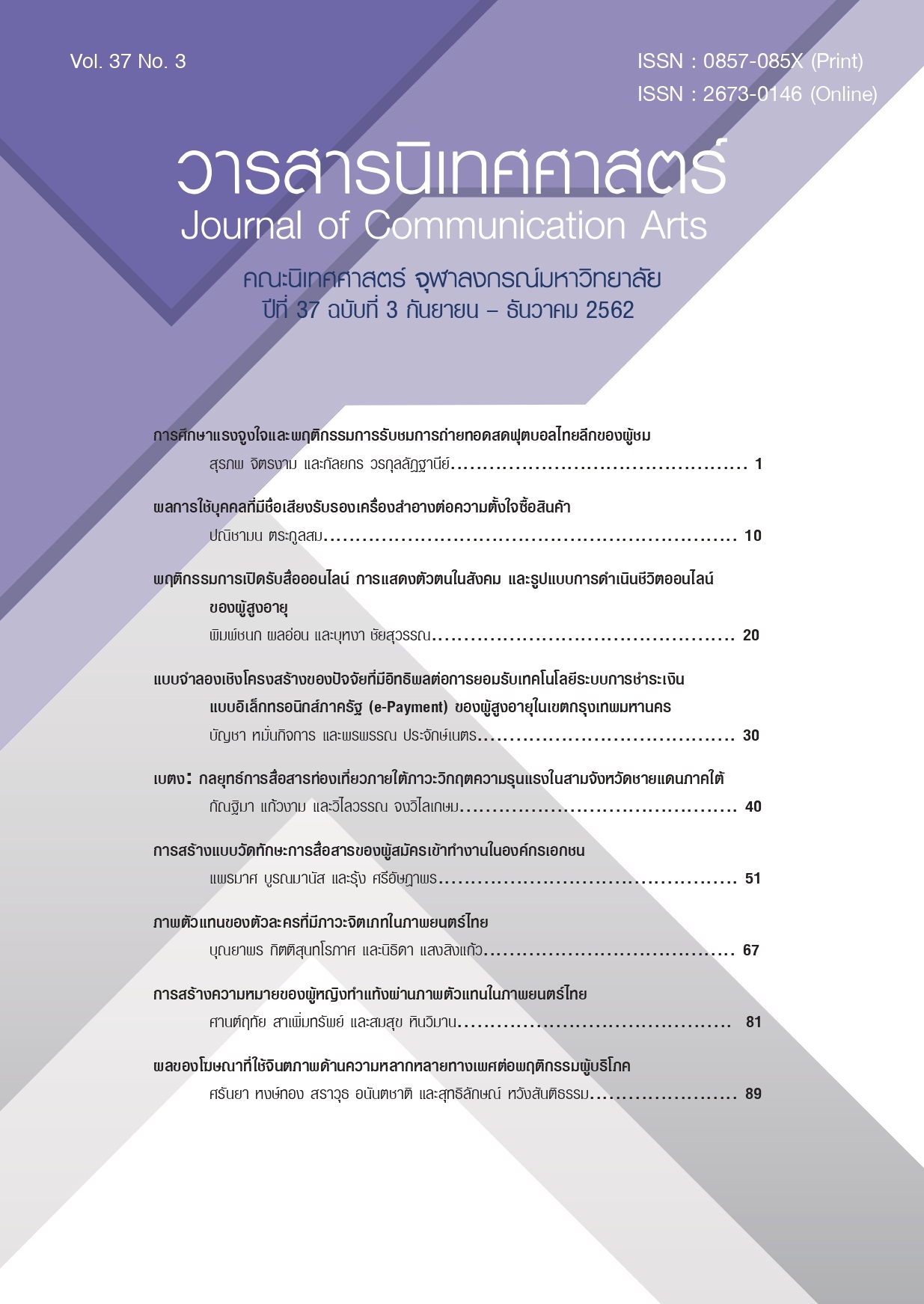Constructing Communication Skill Measurement for Job Applicants in Private Organizations
Main Article Content
Abstract
This study was aimed to explore the indicators of job applicants’ communication skills, to construct and test the quality of communication skill measurement, and to develop the measurement criteria for job applicants. The researcher conducted an in-depth interview with a human resource management executive in an organization to be studied. Job applicants’ communication skill measurement and the measurement criteria were then constructed based upon test specification for the measurement. The criteria of measurement were determined at the three levels of communication competence: 1) the pre-competent level, 2) the threshold level, and 3) the proficient level. The quality of measurement was validated by five experts in the areas of communication, human resource management, and measurement and evaluation. Finally, the pilot test of validated communication skill measurement was conducted with one hundred and thirty samples consisting of one hundred university students and thirty organizational job applicants. Results of this study revealed the five indicators of job applicants’ communication skills. The skill in listening, speaking, reading, writing and interpersonal relations in organizations. Job applicants’ communication skill measurement was constructed in the form of twenty perceptually situational-based multiple-choice questions. Content validity of the measurement was between 0.2-1. Reliability of the measurement was 0.65 at the difficult level of 0.62 and the discriminating power of 0.53. The measurement criteria were determined at the pre-competent, threshold, and proficient levels of communication competence with the scores of sample responses between 20-33, 34-47, and 48-60 respectively.
Article Details
References
เกวลี ขันธ์เงิน. (2551). การพัฒนาความสามารถในการสื่อสารสำหรับพนักงานใหม่ในองค์กรไทย. วิทยานิพนธ์ปริญญามหาบัณฑิต สาขาวิชาวาทวิทยา. จุฬาลงกรณ์มหาวิทยาลัย.
จิราวรรณ วงศ์ดอกไม้ และรุ้ง ศรีอัษฎาพร. (2553). การพัฒนาความสามารถในการสื่อสารสำหรับบุคลากรที่มีศักยภาพสูงในองค์กรรัฐ. วารสารนิเทศศาสตร์, 28(2), 95-107.
ชูชัย สมิทธิไกร. (2552). การสรรหา การคัดเลือก และการประเมินผลการปฏิบัติงานของบุคลากร. กรุงเทพมหานคร: สำนักพิมพ์แห่งจุฬาลงกรณ์มหาวิทยาลัย.
นงลักษณ์ ศรีอัษฎาพร เจริญงาม. (2541). ความสามารถในการสื่อสาร: แนวคิดเชิงวัฒนธรรมในองค์กรไทย. โลกของสื่อ, 1(2), 22-43.
นงลักษณ์ ศรีอัษฎาพร เจริญงาม. (2543). ความสามารถในการสื่อสาร: แนวคิดเชิงนิเวศน์ในองค์กร. วารสารนิเทศศาสตร์, 18(4), 1-18.
น้อย ศรีรัตนพันธ์. (2553). ปัจจัยที่มีอิทธิพลต่อแนวโน้มการลาออกจากงานของพนักงาน กรณีศึกษา บริษัท โคห์เลอร์ (ประเทศไทย) จำกัด (มหาชน) จังหวัดสระบุรี. วิทยานิพนธ์ปริญญามหาบัณฑิต สาขาบริหารธุรกิจ. มหาวิทยาลัยบูรพา.
นิสดารก์ เวชยานนท์. (2554). Competency-based approach. กรุงเทพมหานคร: กราฟิโก ซิสเต็มส์.
ปภัสสรา ชัยวงศ์. (2557). กรอบแนวคิดเชิงทฤษฎีความสามารถในการสื่อสารระหว่างบุคลากรต่างรุ่นในองค์กรไทย. วิทยานิพนธ์ปริญญาดุษฎีบัณฑิต สาขาวิชานิเทศศาสตร์. จุฬาลงกรณ์มหาวิทยาลัย.
ประชาชาติธุรกิจออนไลน์. (2559). จ๊อบไทยเผย 7 ทักษะที่นักศึกษาจบใหม่ยังขาด. วันที่เข้าถึงข้อมูล 30 มีนาคม 2559, แหล่งที่มา https://www.prachachat.net/news_detail.php?newsid=1458194459
มารดารัตน์ สุขสง่า. (2554). ขีดความสามารถที่พึงประสงค์ในการสรรหาและคัดเลือกบุคลากรขององค์กรชั้นนำในประเทศไทย กรณีศึกษา บริษัท ปูนซีเมนต์ไทย จำกัด (มหาชน) (รายงานผลการวิจัย). กรุงเทพมหานคร: มหาวิทยาลัยราช-ภัฏสวนสุนันทา.
รุ้ง ศรีอัษฎาพร. (2558). บุคลิกภาพและความสามารถในการสื่อสารจากวัยเด็กสู่วัยทำงาน (Personality and Communication Competence: From Childhood to Working Age). กรุงเทพมหานคร: สำนักพิมพ์แห่งจุฬาลงกรณ์มหาวิทยาลัย.
วรรณวิสา ดำรงสกุลวงษ์. (2557). ปัจจัยที่มีอิทธิพลต่อแนวโน้มการลาออกของพนักงานในอุตสาหกรรมฟอกหนัก กรณีศึกษา บริษัท อินเตอร์ไฮค์ จำกัด (มหาชน). วิทยานิพนธ์ปริญญามหาบัณฑิต สาขาบริหารธุรกิจ. มหาวิทยาลัยเนชั่น.
ศิริชัย กาญจนวาสี. (2544).ทฤษฎีการทดสอบแบบดั้งเดิม. กรุงเทพมหานคร: โรงพิมพ์แห่งจุฬาลงกรณ์มหาวิทยาลัย.
สำนักงาน ก.พ. (2549). สถิติและอัตราการลาออกของข้าราชการพลเรือน ปีงบประมาณ 2549. วันที่เข้าถึงข้อมูล 30 มีนาคม 2559, แหล่งที่มา https://www.ocsc.go.th
สำนักงาน ก.พ. (2556). กำลังคนภาครัฐ 2556: ข้าราชการพลเรือนสามัญ. วันที่เข้าถึงข้อมูล 30 มีนาคม 2559, แหล่งที่มา https://www.ocsc.go.th
สุวิมล ติรกานันท์. (2550). การสร้างเครื่องมือวัดตัวแปรในการวิจัยทางสังคมศาสตร์: แนวทางสู่การปฏิบัติ. กรุงเทพมหานคร: โรงพิมพ์แห่งจุฬาลงกรณ์มหาวิทยาลัย.
หทัยพร ทิมสว่าง และรุ้ง ศรีอัษฎาพร. (2553). การพัฒนาความสามารถในการสื่อสารสำหรับบุคลากรผู้มีศักยภาพสูงในองค์กรเอกชน. วารสารนิเทศศาสตร์, 28(3), 123-133.
อนันต์ชัย คงจันทร์. (2557). Human resource management การจัดการทรัพยากรมนุษย์. กรุงเทพมหานคร: ห้างหุ้นส่วนจำกัดภาพพิมพ์.
เฮย์ กรุ๊ป. (2556). เฮย์กรุ๊ป เผยผลสำรวจเงินเดือนและการจ่ายโบนัส. วันที่เข้าถึงข้อมูล 11 มีนาคม 2559, แหล่งที่มา https://www.haygroup.com/th/press/details.aspx?id=40744
ภาษาอังกฤษ
Boyle, D. M., Mahoney, D. P., Carpenter, B. W., & Grambo, R. J. (2014). The importance of communication skills at different career levels. The CPA Journal, August, 40-45.
Brounstein, M., Bell, A. H., & Smith, D. M. (2007). Business communication: Communicate effectively in any environment. U.S.A.: John Wiley & Sons Inc.
Crosling, G., & Ward, I. (2002). Oral communication: the workplace needs and uses of business graduate employees. English for Specific Purposes, 21(2002), 41-57.
Hartley, P., & Chatterton, P. (2015). Business Communication: rethinking your professional practice for the post-digital age. New York: Routledge.
Jablin, F. M., & Sias, P. M. (2001). The new handbook of organizational communication: advances in theory, research, and methods (F. M. Jablin & L. L. Putnam Eds.). Califonia: Sage Publications.
Johanson G. A., & Brooks G. P. (2010). Initial scale development: sample size for pilot studies. Educational and Psychological Measurement, 70(3), 394-400.
Mitchell, G. W., Skinner, L. B., & White, B. J. (2010). Essential soft skills for success in the twenty-first century workforce as perceived by business educators. Delta Pi Epsilon Journal, 52(1), 43-53.
Mukerjee, H. S. (2013). Business Communication: connecting at work. New Delhi: Oxford University Press.
Noe, R., Hollenbeck, J., Gerhart, B., & Wright, P. (2011). Fundamental of human resource management. New York: McGraw-Hill Irwin.
Robles, M. M. (2012). Executive perceptions of the top 10 soft skills needed in today’s workplace. Business Communication Quarterly, 75(4), 435-465.
Ruck, K., & Welch, M. (2012). Valuing internal communication; management and employee perspectives. Public Relations Review, 38(2012), 294-302.
Smith, B. D. (2004). Reading strategies for college and everyday life. New York: Pearson Longman.
Sriussadaporn-Charoenngam, N., & Jablin, F. M. (1999). An exploratory study of communication competence in Thai organizations. The Journal of Business Communication, 36(4), 382-418.


